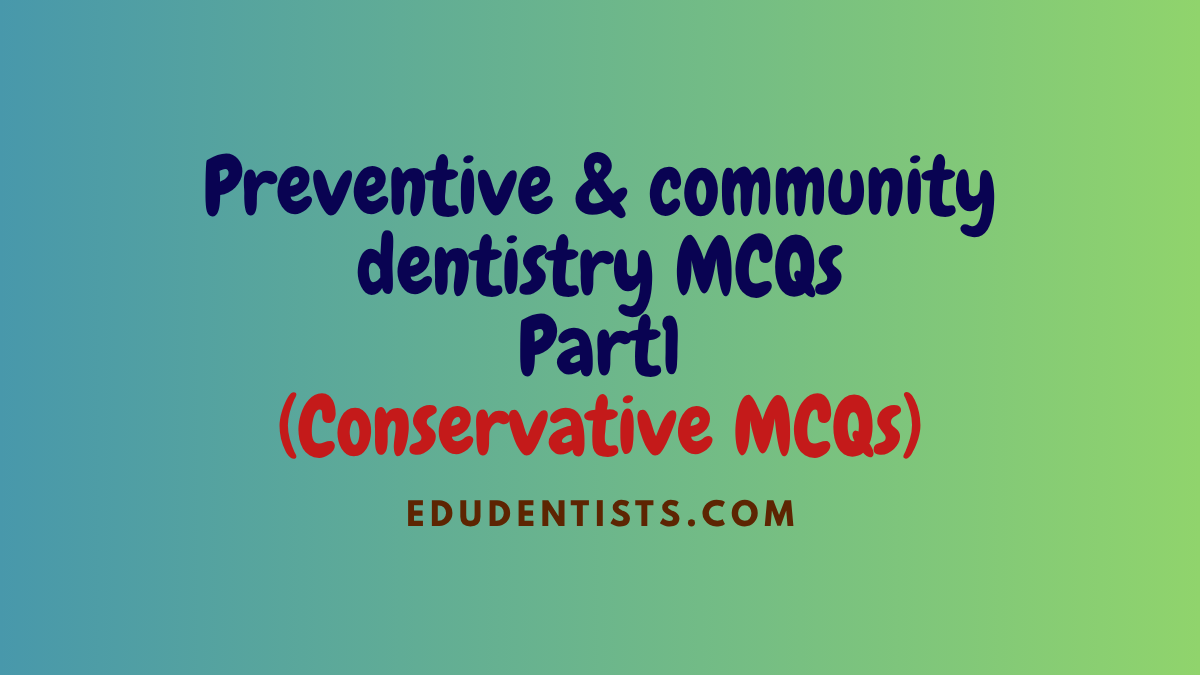
Preventive and community dentistry-Part1 MCQs
Preventive and community dentistry. Fissure sealants MCQs. The reference for these questions is Oxford Handbook of Clinical Dentistry, 6ed
1. What is a fissure sealant?
A. A material that provides an impervious barrier to the fissure system to prevent the development of caries
B. A chemical solution used to treat enamel
C. A type of restoration used to seal fissures
D. A type of toothbrush designed to clean fissures
2. What is the main purpose of fissure sealants?
A. To remove plaque from pits and fissures
B. To restore fissures with amalgam
C. To provide an impervious barrier to the fissure system to prevent the development of caries
D. To chemically treat enamel with silver nitrate
3. What are some historical approaches to decrease fissure caries?
A. Chemical treatment of enamel
B. Prophylactic odontotomy
C. Sealing of fissures with various materials
D. All of the above
4. Are fissure sealants effective in preventing caries?
A. Yes, if applied to susceptible teeth and monitored regularly
B. No, they do not have any effect on caries prevention
C. Only for primary teeth
D. Only for permanent teeth
5. Who should receive fissure sealants?
A. Children with impairments
B. Children with extensive caries in the primary dentition
C. Children with caries-free primary dentitions
D. A and B
E. All of the above
6. What is a fissure sealant?
A. A material that helps to clean teeth
B. A material that provides an impervious barrier to the fissure system to prevent the development of caries
C. A type of toothpaste
D. A type of toothbrush
7. What is the most common type of fissure sealant?
A. Silver Nitrate
B. Amalgam
D. Composite resin used with an acid-etch technique
E. Polyurethane
8. What are some historical approaches to decreasing fissure caries?
A. Brushing and flossing
B. Chemical treatment of the enamel with silver nitrate
C. Prophylactic odontotomy
D. All of the above
9. Is there a need for sealants in developed countries?
A. Yes, due to the decrease in caries seen in recent years has not been uniform for all tooth surfaces.
B. No, because of the increase availability of fluoride
C. Only for children
D. Only for adults
10. Are sealants effective?
A. Yes, when carefully applied to susceptible teeth.
B. No, never effective
C. Only for primary teeth
D. Only for adult teeth
11. When should teeth be sealed for maximum benefit?
A. After toothbrush
B. As soon as possible after eruption and certainly within 2 years
C. Before toothbrush
D. After 2 years of eruption
12. Who should receive fissure sealants?
A. Children with impairments and those with extensive caries in the primary dentition
B. Children with caries-free primary dentitions
C. Only adults
D. Only children
13. Which teeth should be sealed?
A. All susceptible fissures of permanent teeth
B. Only primary teeth
C. Only incisors
D. Only molars
14. What should be done if there is doubt about a stained fissure?
A. Ignore it
B. A black and white X-ray should be taken
C. Place a PRR
D. Place a conventional restoration
15. What is the retention rate of composite resin-based sealants?
A. Greater than 85% after 1 year and greater than 50% after 5 years
B. Less than 85% after 1 year and less than 50% after 5 years
C. 100% retention rate
D. No retention rate
16. What are the types of fissure sealant?
A. Light- or self-cure, resin system, color and filled or unfilled
B. Hard- or soft-cure, resin type, color and filled or unfilled
C. Fast- or slow-cure, resin type, color and filled or unfilled
D. Easy- or difficult-cure, resin type, color and filled or unfilled
17. What is the advantage of colored/opaque sealants?
A. They are more readily obvious to the patient
B. They are more effective
C. They are cheaper
D. They are easier to apply
18. What is the retention rate of the different types of sealant?
A. Different retention rates
B. Similar retention rates
C. No retention rate
D. 100% retention rate
19. What are G.I sealants useful for?
A. High caries-risk children as a temporary sealant where adequate isolation for successful placement of resin-based sealants is not possible
B. Low caries-risk children as a temporary sealant where adequate isolation for successful placement of resin-based sealants is possible
C. Adults as a temporary sealant
D. High caries-risk children as a permanent sealant
20. What is the first step of resin fissure sealant technique?
A. Apply f/s
B. Prophylaxis
C. Isolate and dry the tooth
D. Etch for the time recommended by the manufacturer
21. How often should fissure sealants be monitored?
A. Once a year
B. Once a month
C. Once a week
D. Clinically and where appropriate, radiographically
22. What should be done with defective sealants?
A. Ignore them
B. Remove them
C. Replenish them to maintain their marginal integrity
D. Replace them